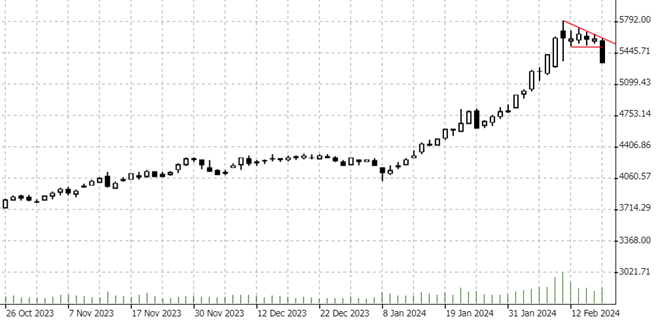

19.02.2024 – It can happen that fast: After a strong rally, cocoa has corrected just as sharply. We shed light on the background. This much in advance: large speculative addresses were at work here.
The “bullish beast” has been hunted down: After a massive rise, the cocoa bull market has collapsed. Here is the daily chart. A little more chart analysis: the consolidation and then the breakthrough in the descending triangle can be seen very clearly.

Source: Bernstein Bank GmbH
This is a typical example of what happens when big names storm a narrow market. Even the slightest change in sentiment is then the signal for a brutal sell-off.
Stampede of the chocolate bulls
At the weekend, the Financial Times reported: “Hedge fund stampede into cocoa futures fuels record price jump”. It went on to say: “Speculative traders have amassed an $8.7bn bet on further gains, the largest ever.” Since the end of last year, massive amounts of funds have poured into the market. We add: This movement can be seen very nicely at the top of the rising chart. According to the Commodity Futures Trading Commission, the inflow of around 9 billion dollars in contracts in London and New York was the largest ever recorded. And so cocoa reached a new price peak, which was around twice as high as a year ago.
Weather and hedge funds
Hedge funds had fuelled the weather-related rally, the FT continued. The paper quoted Martijn Bron, who was the global head of cocoa and chocolate trading for chocolate giant Cargill until 2022: the funds had the “biggest risk exposure to cocoa that they’ve ever had”. He continued: “Hedge funds are not the cause of the rise, but in a lower liquidity market environment, they can amplify fundamentally justified market moves to extreme levels.”
Justin Grandison, Director of Cocoa Brokerage at ABN AMRO Bank, also stated “an influx of money into soft commodities” in an interview with the FT. Some of these funds have returned to the market after six to eight years. Many of them rely heavily on algorithms to analyse market trends. We think so: Computers have thus reinforced the trend. “Various speculative traders that have not been trading cocoa for a long time have now jumped in,” added Harold de Boer, Managing Director at Transtrend, a quantitatively orientated hedge fund in Rotterdam.
Demand concerns
And then the mountain started to slide: According to “Barchart.com”, worries that high prices will stifle global demand have recently become more widespread on the trading floor. This has led to a wave of long liquidations in overbought territory. In other words, some bulls have cut their initial losses, triggering a chain reaction. At the same time, we are wondering whether some big names have pushed the price over the cliff with short positions and targeted selling.
Our conclusion: We are curious to see whether this was just a brief correction in which some bulls were killed. After all, the fundamentals have not changed – the growing world population loves chocolate, the Sahara wind Harmattan and various diseases are jeopardising supply. But perhaps the slide of the mountain is not over yet. Bernstein Bank wishes you successful trades and investments!
__________________________________________________________________________________________________________________________________________________
The content of this publication is for general information purposes only. In this context, it is neither an individual investment recommendation or advice nor an offer to purchase or sell securities or other financial products. The content in question and all the information contained therein do not in any way replace individual investor- or investment-oriented advice. No reliable forecast or indication for the future is possible with respect to any presentation or information on the present or past performance of the relevant underlying assets. All information and data presented in this publication are based on reliable sources. However, Bernstein Bank does not guarantee that the information and data contained in this publication is up-to-date, correct and complete. Securities traded on the financial markets are subject to price fluctuations. A contract for difference (CFD) is also a financial instrument with leverage effect. Against this backdrop, CFD trading involves a high risk up to the point of total loss and may not be suitable for all investors. Therefore, make sure that you have fully understood all the correlating risks. If necessary, ask for independent advice. CFDs are complex instruments and are associated with the high risk of losing money quickly because of the leverage effect. 68% of retail investor accounts lose money trading CFD with this provider. You should consider whether you understand how CFD work and whether you can afford to take the high risk of losing your money.7
